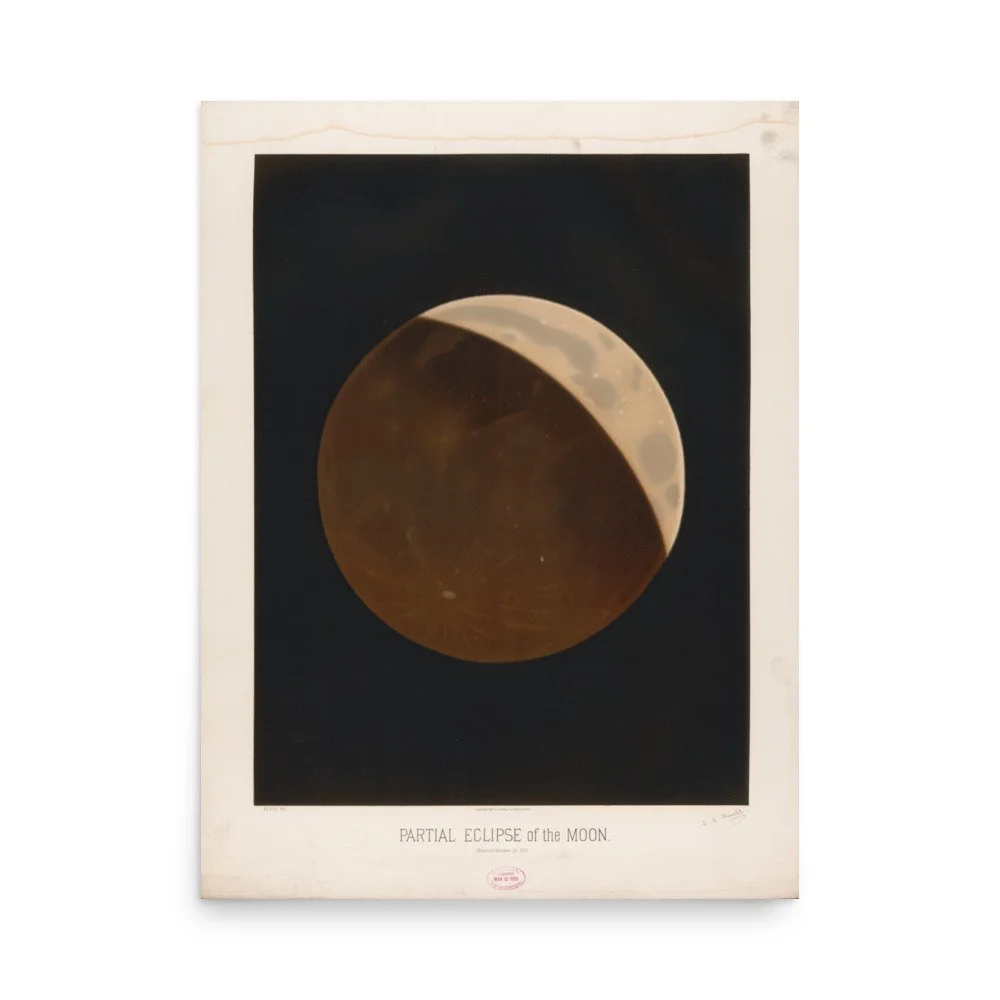 Image 1 of 1
Image 1 of 1


Partial Eclipse of the Moon Print
$28.00
Observed October 24, 1874, by Étienne Léopold Trouvelot. Published by Charles Scribner’s Sons. And reproduced on archival matte paper.
In the late nineteenth century, long before the camera’s lens came to define how we see the night sky, the French astronomer and artist Étienne Léopold Trouvelot sought to translate celestial motion into human vision. His Partial Eclipse of the Moon, observed in 1874, is both scientific record and nocturne, a moment when the heavens themselves seem to dim and breathe. The moon, rendered in bruised copper and milk-white light, hovers between illumination and erasure.
Trouvelot, whose work bridged the observatory and the salon, believed that art could capture what instruments could only measure. His image, quiet, exacting, and strangely intimate, invites the viewer into that ancient paradox: that darkness is not the absence of light, but its necessary companion. In this, it feels perfectly at home in autumn, when evenings arrive early and the familiar world grows spectral at the edges.
• 18" x 24"
• Paper thickness: 10.3 mil
• Paper weight: 189 g/m²
• Opacity: 94%
• ISO brightness: 104%
• Paper is sourced from Japan
In the late nineteenth century, long before the camera’s lens came to define how we see the night sky, the French astronomer and artist Étienne Léopold Trouvelot sought to translate celestial motion into human vision. His Partial Eclipse of the Moon, observed in 1874, is both scientific record and nocturne, a moment when the heavens themselves seem to dim and breathe. The moon, rendered in bruised copper and milk-white light, hovers between illumination and erasure.
Trouvelot, whose work bridged the observatory and the salon, believed that art could capture what instruments could only measure. His image, quiet, exacting, and strangely intimate, invites the viewer into that ancient paradox: that darkness is not the absence of light, but its necessary companion. In this, it feels perfectly at home in autumn, when evenings arrive early and the familiar world grows spectral at the edges.
• 18" x 24"
• Paper thickness: 10.3 mil
• Paper weight: 189 g/m²
• Opacity: 94%
• ISO brightness: 104%
• Paper is sourced from Japan
Observed October 24, 1874, by Étienne Léopold Trouvelot. Published by Charles Scribner’s Sons. And reproduced on archival matte paper.
In the late nineteenth century, long before the camera’s lens came to define how we see the night sky, the French astronomer and artist Étienne Léopold Trouvelot sought to translate celestial motion into human vision. His Partial Eclipse of the Moon, observed in 1874, is both scientific record and nocturne, a moment when the heavens themselves seem to dim and breathe. The moon, rendered in bruised copper and milk-white light, hovers between illumination and erasure.
Trouvelot, whose work bridged the observatory and the salon, believed that art could capture what instruments could only measure. His image, quiet, exacting, and strangely intimate, invites the viewer into that ancient paradox: that darkness is not the absence of light, but its necessary companion. In this, it feels perfectly at home in autumn, when evenings arrive early and the familiar world grows spectral at the edges.
• 18" x 24"
• Paper thickness: 10.3 mil
• Paper weight: 189 g/m²
• Opacity: 94%
• ISO brightness: 104%
• Paper is sourced from Japan
In the late nineteenth century, long before the camera’s lens came to define how we see the night sky, the French astronomer and artist Étienne Léopold Trouvelot sought to translate celestial motion into human vision. His Partial Eclipse of the Moon, observed in 1874, is both scientific record and nocturne, a moment when the heavens themselves seem to dim and breathe. The moon, rendered in bruised copper and milk-white light, hovers between illumination and erasure.
Trouvelot, whose work bridged the observatory and the salon, believed that art could capture what instruments could only measure. His image, quiet, exacting, and strangely intimate, invites the viewer into that ancient paradox: that darkness is not the absence of light, but its necessary companion. In this, it feels perfectly at home in autumn, when evenings arrive early and the familiar world grows spectral at the edges.
• 18" x 24"
• Paper thickness: 10.3 mil
• Paper weight: 189 g/m²
• Opacity: 94%
• ISO brightness: 104%
• Paper is sourced from Japan

